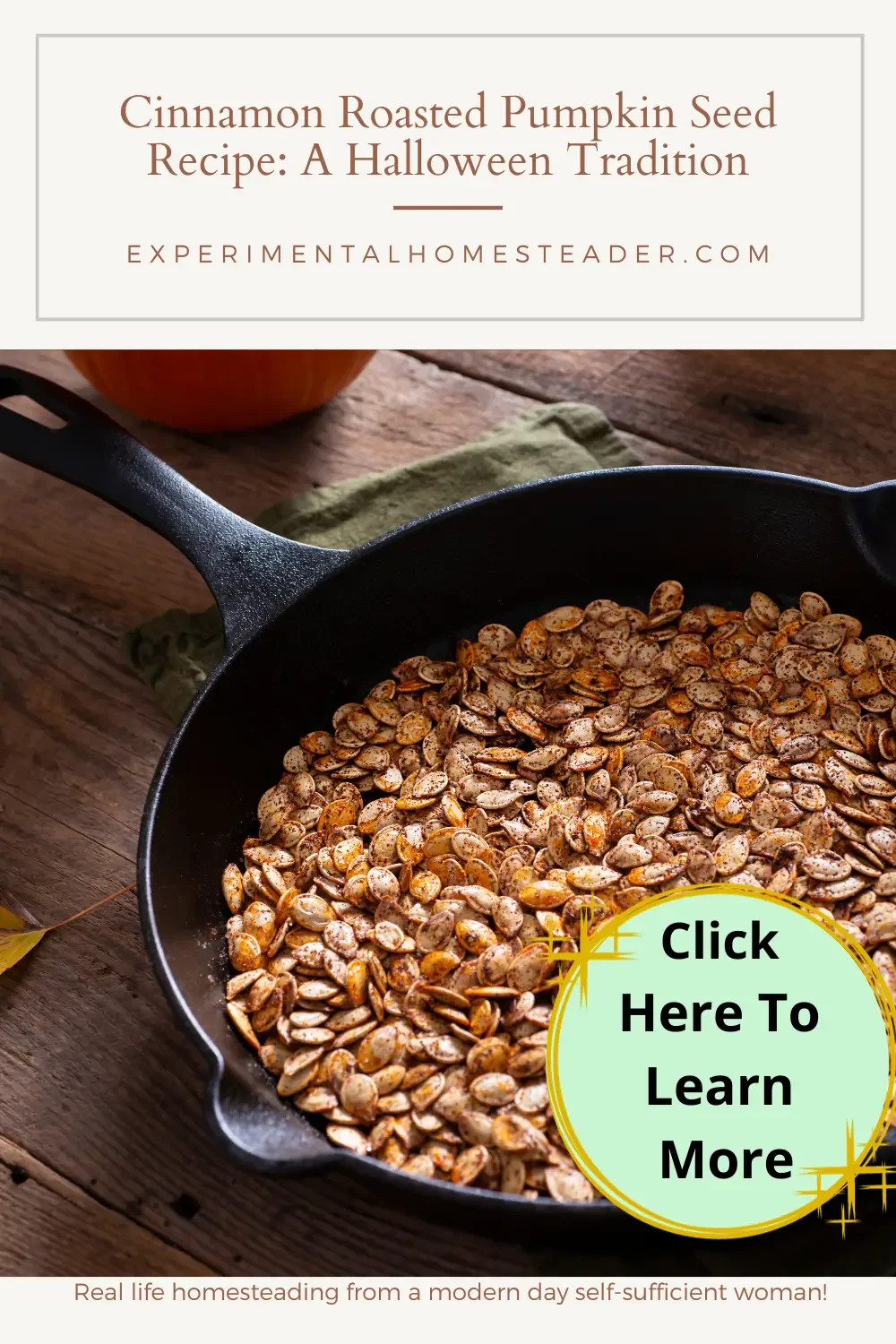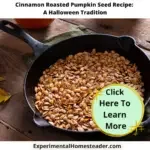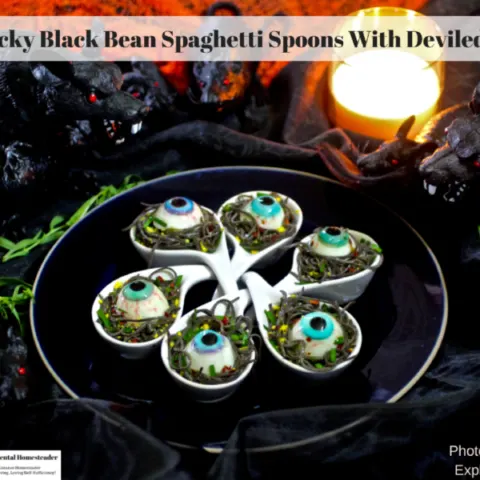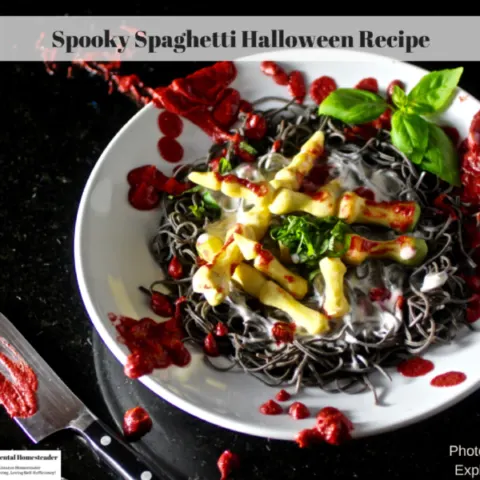Halloween is just around the corner, and as homesteaders, we have a unique way of approaching this spooky season.
While many people see Halloween as a time for costumes and candy, we see it as an opportunity to celebrate our homesteading lifestyle.
In this blog post, we’ll explore the delightful intersection of Halloween and homesteading through the art of pumpkin carving and seed saving.
Every year for Halloween, the excitement in our home begins with a simple yet cherished tradition – pumpkin carving.
It’s a time when my daughter’s imagination takes center stage as we transform pumpkins into whatever she’s passionate about that year.
From whimsical Wiggles characters to the elusive ghost, we’ve tackled it all.
As the designated carver, I eagerly await her choice for this year’s design.
But our Halloween festivities don’t end with carving.
We have another beloved tradition that follows – roasting pumpkin seeds for our cinnamon roasted pumpkin seed recipe.
Carving Spooky Pumpkins
Carving pumpkins is a cherished Halloween tradition that allows us to tap into our creative side.
Whether you’re crafting a spooky face, a whimsical design, or something entirely unique, the possibilities are endless. Here are some tips to get you started:
- Choose the Right Pumpkin: Select a healthy, ripe pumpkin with a flat base to ensure stability during carving.
- Gather Your Tools: You’ll need a sharp knife, a scoop or spoon for removing seeds and pulp, and carving templates if you’re looking for precision.
- Safety First: Carving can be tricky, so be sure to supervise children and use appropriate tools to avoid accidents.
- Preserve Your Masterpiece: To prolong your pumpkin’s freshness, consider spraying it with a mixture of water and a few drops of bleach. This can help prevent mold and decay.
Family Bonding and Homesteading Spirit
One of the beautiful aspects of pumpkin carving is that it brings families and friends together.
It’s an opportunity to spend quality time with loved ones, sharing stories and laughter while creating memorable decorations for your homestead.
The act of carving itself aligns with the homesteading spirit of self-sufficiency, as you transform a homegrown pumpkin into a work of art.
Saving Pumpkin Seeds
Now, let’s not waste the treasure hidden within the pumpkin—the seeds!
Pumpkin seeds are not only delicious when roasted with your favorite seasonings, but they also have significant value for homesteaders.
Here’s why you should consider saving them:
- Sustainable Seed Source: By saving your pumpkin seeds, you reduce the need to purchase seeds from external sources, making your homestead more self-sufficient.
- Cost-Efficient: It’s a cost-effective way to ensure a steady supply of pumpkins for your homestead.
- Preservation of Heirloom Varieties: If you’re growing heirloom pumpkin varieties, seed saving becomes essential to maintain these unique strains.
- Roasted Pumpkin Seeds: Don’t forget the delicious aspect – roasted pumpkin seeds make for a healthy and tasty snack. They’re packed with nutrients like zinc, magnesium, and protein.
Steps to Save Pumpkin Seeds
Here’s how you can go about saving pumpkin seeds for future harvests:
- Seed Selection: Choose mature pumpkins for seed saving. These are typically the ones you allow to fully ripen on the vine.
- Seed Extraction: When carving your pumpkin, set aside the seeds and pulp in a separate bowl. You can do this by scooping them out with a spoon.
- Seed Cleaning: Rinse the seeds thoroughly to remove any remaining pumpkin flesh. Use a strainer to help with this process.
- Drying: Lay the cleaned seeds out on a paper towel or a clean cloth to air dry. This can take a few days.
- Storage: Once fully dry, store the seeds in a cool, dry place. You can use envelopes or glass jars for this purpose.
Tips for Successful Seed Saving
- Isolation Distance: If you’re growing different pumpkin varieties and want to save seeds for purity, ensure a proper isolation distance to prevent cross-pollination.
- Labeling: Always label your seed containers with the pumpkin variety and the date of seed saving to keep things organized.
- Viability Testing: To check the viability of your saved seeds, perform a germination test by planting a few in a separate container before the next planting season.
Our Pumpkin Seed Tradition: From Messy Beginnings to Delicious Endings
Despite the occasional hassle of separating seeds from the gooey pumpkin innards, it’s a step we wouldn’t dare skip.
It’s a chore I take on, even though the insides tend to irritate my skin.
Yet, seeing my daughter’s eyes light up when she spots that stack of seeds makes it all worthwhile.
The process of roasting pumpkin seeds has become a yearly event, and while I’m not entirely sure it’s the “proper” way, it’s our way, and it works for us.
Here’s how we do it:
PrintCinnamon Roasted Pumpkin Seed Recipe: A Halloween Tradition
Ingredients
4 cups pumpkin seeds
1/2 cup butter
2 tbsp. brown sugar
1 tbsp. ground cinnamon
1/4 tsp. salt
1/4 cup granulated sugar
Instructions
- Seed Harvest: After carving the pumpkin, separate the seeds from the pulp. My daughter loves this part, as she can indulge in the gooey mess.
- Clean and Dry: Rinse the pumpkin seeds to remove any remaining pulp, and then lay them out to dry on a clean kitchen towel or paper towels. Pat them dry if needed.
- Seasoning: In a bowl, toss the dried pumpkin seeds with the melted the butter. Add the brown sugar, cinnamon and salt. Stir to coat the seeds. Adjust the seasonings to your taste.
- Roasting: Preheat your oven to 350°F. Spread the seasoned pumpkin seeds in a single layer on a cookie sheet lined with aluminum foil. Roast them for approximately 20-30 minutes or until they turn golden brown, stirring occasionally for even roasting.
- Cooling: Once roasted to perfection, take the seeds out of the oven and allow them to cool on the baking sheet. They’ll continue to crisp up as they cool.
Creative and Nutritious Uses for Pumpkin Seeds
Pumpkin seeds are not only delicious when roasted, but they can also be used in various edible ways.
Here are some tasty and nutritious uses for pumpkin seeds:
- Snacking: Roasted pumpkin seeds make for a healthy and satisfying snack. You can season them with your favorite spices or simply toss them with a bit of salt for a crunchy treat.
- Salad Topping: Add a delightful crunch to your salads by sprinkling roasted pumpkin seeds on top. They pair well with both leafy green salads and hearty grain salads.
- Trail Mix: Incorporate pumpkin seeds into your homemade trail mix along with nuts, dried fruits, and chocolate chips for a balanced and energy-boosting snack.
- Baking: Pumpkin seeds can be used in baking recipes. Add them to muffins, cookies, or bread for extra texture and nutty flavor.
- Smoothie Booster: Blend roasted pumpkin seeds into your morning smoothie to increase its nutritional value. They add protein, healthy fats, and a subtle nutty taste.
- Granola: Make your own homemade granola and include pumpkin seeds for an extra layer of flavor and nutrition.
- Soup Garnish: Sprinkle roasted pumpkin seeds on top of soups, like butternut squash or pumpkin soup, for a delightful contrast in texture.
- Pesto: Consider using pumpkin seeds instead of pine nuts in your pesto sauce. They create a unique flavor profile while still providing a creamy texture.
- Pumpkin Seed Butter: Just like almond or peanut butter, you can make pumpkin seed butter by blending roasted pumpkin seeds. It’s a great spread for toast, sandwiches, or as a dip for fruit and veggies.
- Cereal Topping: Add a handful of pumpkin seeds to your morning cereal or oatmeal for an extra boost of nutrition.
- Homemade Protein Bars: Incorporate roasted pumpkin seeds into your homemade protein bar or energy bar recipes for added protein and crunch.
- Yogurt Mix-In: Sprinkle pumpkin seeds on top of your yogurt or yogurt parfait to elevate the texture and add a dose of healthy fats.
- Stir-Fry: Toss roasted pumpkin seeds into stir-fry dishes for an unexpected nutty element.
- Garnish for Desserts: Use roasted pumpkin seeds as a garnish for desserts like ice cream, puddings, or fruit salads to add a satisfying crunch.
- Grain Bowls: Whether it’s a rice, quinoa, or couscous bowl, roasted pumpkin seeds make an excellent topping to enhance both flavor and nutrition.
These are just a few creative ways to incorporate pumpkin seeds into your meals and snacks.
They’re not only tasty but also packed with nutrients like protein, fiber, healthy fats, and vitamins.
So, don’t let those pumpkin seeds go to waste; put them to good use in your kitchen!
Roasting Pumpkin Seeds with Flavorful Seasonings
Some people like to boil the seeds before roasting to ensure they’re tender on the inside.
To do this, bring a pot of water to a boil, add the cleaned seeds, and a pinch of salt.
Simmer for about 10 minutes.
This step is optional, and you can skip it if you prefer a slightly crunchier texture.
Savory Pumpkin Seed Seasonings:
- Classic Salted: Toss the seeds with olive oil and sprinkle them generously with sea salt for a simple and savory snack.
- Garlic and Parmesan: Mix the seeds with minced garlic, grated Parmesan cheese, and a pinch of salt for a savory, cheesy twist.
- Spicy Kick: Add some heat with cayenne pepper, paprika, and a touch of cumin for a spicy flavor.
- Soy Sauce and Sesame: Combine soy sauce, sesame oil, and sesame seeds for an Asian-inspired flavor profile.
- Ranch Seasoning: Sprinkle ranch seasoning mix over the seeds for a tangy and herby taste.
- Barbecue: Create a barbecue flavor by mixing in barbecue seasoning or a smoky paprika blend.
Sweet Pumpkin Seed Seasonings:
- Cinnamon Sugar: Toss the seeds in melted butter and sprinkle them with a mixture of cinnamon and sugar for a sweet treat.
- Honey Roasted: Drizzle honey over the seeds and add a pinch of cinnamon for a naturally sweet and slightly spicy flavor.
- Maple Glaze: Mix maple syrup, a bit of melted butter, and a touch of salt for a delightful autumn flavor.
- Pumpkin Spice: Capture the essence of fall with a mix of pumpkin pie spice and brown sugar.
- Chocolate Covered: After roasting, you can coat the seeds in melted chocolate for an indulgent sweet treat.
- Caramelized: Make caramelized pumpkin seeds by cooking them with brown sugar and a bit of butter until they form a sweet, crunchy coating.
Remember to adjust the quantity of seasonings to your taste preference, and don’t be afraid to get creative by combining different flavors.
Roasted pumpkin seeds are incredibly versatile and can be customized to suit your cravings, whether you prefer savory or sweet snacks.
Enjoy experimenting with these seasonings!
And for those who would like to make their own homemade pumpkin spice seasoning, here is a recipe:
PrintHomemade Pumpkin Spice Seasoning
This homemade pumpkin spice blend captures the essence of autumn with its rich, aromatic flavors. Feel free to adjust the proportions to match your taste preferences, whether you prefer a stronger cinnamon note or a hint of extra ginger. Enjoy the warmth and comfort it brings to your fall and holiday culinary creations!
Ingredients
3 tablespoons ground cinnamon
2 teaspoons ground ginger
2 teaspoons ground nutmeg
1 1/2 teaspoons ground allspice
1 1/2 teaspoons ground cloves
Instructions
- Gather Your Ingredients: Assemble the ground spices you’ll need: cinnamon, ginger, nutmeg, allspice, and cloves.
- Mix the Spices: In a small bowl, combine all the spices. You can adjust the quantities to your liking. If you prefer a more prominent cinnamon flavor, you can increase the amount of cinnamon, for example.
- Whisk or Stir: Use a whisk or a spoon to thoroughly mix the spices together. Make sure they are evenly distributed to create a well-balanced pumpkin spice blend.
- Store: Transfer your homemade pumpkin spice seasoning to an airtight container or spice jar. Store it in a cool, dry place, away from direct sunlight.
Notes
Tips:
- Fresh Spices: For the best flavor, try to use freshly ground spices. You can grind whole nutmeg and cloves with a spice grinder or mortar and pestle.
- Customization: Feel free to adjust the blend to your taste. If you love the warmth of ginger, add a bit more. If you want it extra spicy, increase the amount of cloves or allspice.
- Use Quality Spices: The quality of your spices will impact the flavor of your pumpkin spice blend, so use high-quality spices for the best results.
Now that you have your homemade pumpkin spice seasoning, you can use it in a variety of recipes, from pumpkin pies and lattes to oatmeal and even roasted pumpkin seeds for that perfect fall flavor.
Usage:
- Add a teaspoon or two to your morning coffee or latte for a warm and cozy twist.
- Sprinkle over oatmeal, pancakes, or waffles to infuse them with fall flavors.
- Use it as a seasoning for baked goods like pumpkin pie, muffins, and cookies.
- Enhance the flavor of your sweet potato dishes, from casseroles to fries.
- Add a dash to whipped cream or frosting for a pumpkin-spiced topping.
- Use it in savory dishes like roasted butternut squash or in your favorite fall soups.
- Share it as a homemade gift during the holiday season, packaged in a decorative jar.
Enjoying Homesteading Halloween Traditions
This Halloween season, let’s celebrate the spooky and sustainable side of homesteading by carving those pumpkins and preserving their seeds.
It’s a joyful activity that connects us to tradition, nature, and the beauty of self-reliance.
Share the love for homesteading, one pumpkin at a time!
As homesteaders, we understand that every action can be an opportunity to embrace our way of life.
So, as you carve those pumpkins and save their seeds, remember that you’re not just creating Halloween decorations; you’re cultivating a deeper connection with the land and a stronger sense of self-sufficiency.
I’m so grateful that my daughter looks forward to this pumpkin seed tradition every year.
It’s not just about the delicious snack; it’s about teaching her to appreciate the simple joys of seasonal foods.
Pumpkin seeds might not be the most nutritious snack, but they’re a healthier alternative to cookies or gummy bears.
It’s all part of keeping her curious about new flavors and experiences, even if it’s something we can only enjoy once a year.
This year, as I prepare to carve the pumpkin and roast those seeds, I can’t help but smile, knowing that my daughter’s enthusiasm for this tradition continues to grow.
It’s a reminder of the magic that lies in the little things – like the annual pumpkin seed adventure we share together.
Frequently Asked Questions About Roasting Pumpkin Seeds
Q: What are pumpkin seeds?
A: Pumpkin seeds, or pepitas, are those edible seeds tucked away inside pumpkins. They’re a tasty little treasure!
Q: Are pumpkin seeds healthy?
A: Absolutely! Pumpkin seeds are like nature’s multivitamin – they’re loaded with nutrients like protein, good fats, fiber, vitamins, and minerals. They’re a nutritious snack that your body will thank you for.
Q: How do I harvest pumpkin seeds from a fresh pumpkin?
A: It’s pretty simple. First, scoop out the seeds and gooey stuff from the pumpkin. Then, separate the seeds, give them a rinse, and let them air dry. That’s the first step to roasting goodness.
Q: Can I eat pumpkin seeds raw?
A: Sure thing! You can munch on raw pumpkin seeds, but if you want to level up their flavor and crunch, roasting them is the way to go.
Q: How do I roast pumpkin seeds?
A: Roasting is easy-peasy. Rinse the seeds, toss them in your favorite seasonings (get creative!), and pop them in the oven at 300°F (150°C). Stir them occasionally until they’re a golden delight.
Q: What seasonings can I use for roasted pumpkin seeds?
A: It’s a flavor adventure! You can go classic with salt, add a kick with garlic or paprika, or satisfy your sweet tooth with cinnamon or sugar. The choice is yours.
Q: Can I use pumpkin spice for roasted seeds?
A: While pumpkin spice is a baking superstar, a dash of it can bring a unique twist to your roasted seeds. Give it a whirl!
Q: How do I make homemade pumpkin spice seasoning?
A: Whip up your own pumpkin spice blend by mixing ground cinnamon, ginger, nutmeg, allspice, and cloves. Adjust the quantities to your taste – it’s like crafting your flavor magic.
Q: What are some sweet uses for pumpkin spice?
A: Pumpkin spice isn’t just for pies. Try it in lattes, pancakes, muffins, and even sweet roasted pumpkin seeds. It adds a cozy warmth to everything.
Q: Can I use pumpkin spice in savory dishes?
A: Absolutely! While it’s known for its sweet side, a pinch of pumpkin spice can add depth and earthiness to savory dishes like roasted veggies or chili.
Q: How do I store homemade pumpkin spice?
A: Keep it fresh by storing your homemade pumpkin spice in an airtight container. A cool, dry place away from sunlight will do the trick.
Q: What’s the shelf life of pumpkin spice?
A: Pumpkin spice can keep its flavor for about 1-2 years when stored properly. But let’s be honest, it’s so good it won’t last that long!
Q: Can I use store-bought pumpkin spice?
A: Absolutely! Store-bought pumpkin spice blends are convenient and work like a charm in many recipes. No need to reinvent the spice wheel.
Q: Are pumpkin seeds gluten-free?
A: You bet! Pumpkin seeds are naturally gluten-free, making them a smart choice for those with gluten sensitivity.
Q: Can I eat the pumpkin seed shell?
A: While the shell is technically edible, most folks prefer to remove it when roasting for a smoother and crunchier snack.
Q: What’s the difference between raw and roasted pumpkin seeds?
A: Roasted pumpkin seeds have a satisfying crunch and a flavor that’s dialed up a notch compared to their raw counterparts.
Q: Can I use pumpkin seeds in cooking and baking?
A: Absolutely! Pumpkin seeds can shine in both sweet and savory recipes. They’re like a versatile little flavor booster.
Q: What’s the nutritional value of pumpkin seeds?
A: Pumpkin seeds are nutritional powerhouses, boasting protein, healthy fats, fiber, vitamins (especially B vitamins), and essential minerals like magnesium and zinc. They’re like nature’s energy snack!
Q: Can I make my own pumpkin seed butter?
A: Yes, indeed! Blend roasted pumpkin seeds in a food processor or blender, and you’ll have creamy and nutritious homemade pumpkin seed butter. It’s perfect for spreading on toast or using in recipes.
Q: Are there any allergies associated with pumpkin seeds?
A: While it’s rare, some folks may have allergies to pumpkin seeds. If you’re uncertain, it’s a good idea to consult with a healthcare professional before indulging. Safety first!
Halloween Dinner Ideas
Garlicky Black Bean Spaghetti Spoons With Deviled Eyes
These garlicky black bean spaghetti spoons with deviled eyes are the perfect scary halloween food for parties for kids and adults alike!
Spooky Spaghetti Halloween Recipe
When it comes to scary halloween food, this spooky spaghetti halloween recipe is one you want on your menu! Be sure to check this recipe out!
Halloween Main Course Dinner Ideas
Halloween main course dinner ideas can be tough to come up with, especially if you are planning a Halloween dinner party. Here are some awesome main course dinner ideas, both from my own blog and from bloggers around the world who have agreed to let me share their ideas with you.










